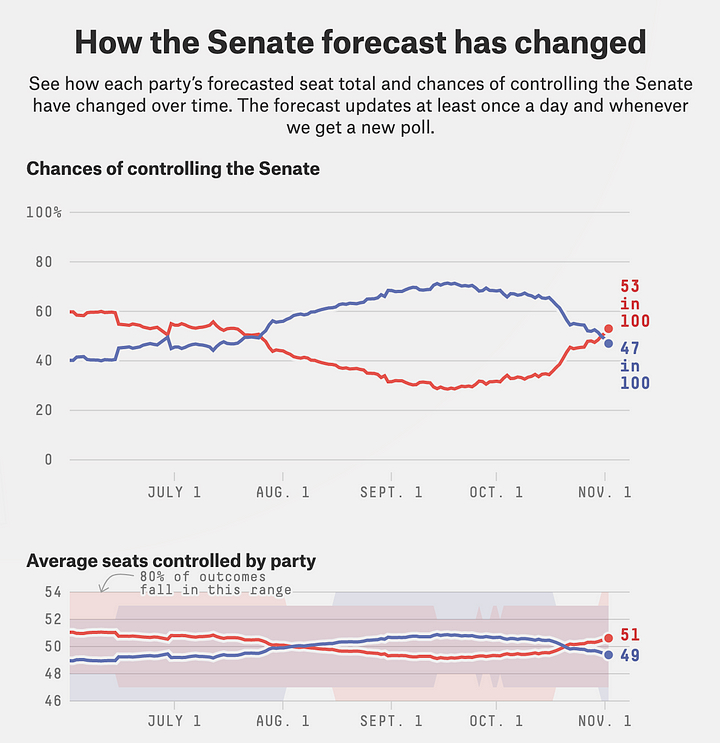In the realm of American politics, predicting the outcomes of elections has become an increasingly intricate and data-driven endeavor. As the nation gears up for the 2024 Senate elections, political enthusiasts and analysts eagerly seek insight into the potential results. One prominent source for such predictions is FiveThirtyEight (538), a well-respected data journalism website that utilizes complex models to forecast election outcomes. In this article, we will delve into the 538 Senate prediction model for 2024, exploring its methodology, past successes, and potential challenges, all with the aim of deciphering the numbers behind the predictions.
Understanding 538 Senate Prediction Approach

Before we dive into the analysis of the 538 Senate prediction model for 2024, it’s essential to grasp the methodology that underpins their forecasts. FiveThirtyEight employs a combination of polling data, historical election results, and other relevant factors to develop their prediction models. These models are designed to simulate thousands of possible election scenarios, taking into account a range of variables such as candidate popularity, economic indicators, and even the political climate.
One critical component of the 538 approach is their polling aggregation. They collect and analyze a wide array of polls, giving more weight to polls with better historical accuracy and methodologies. This approach aims to provide a more comprehensive and reliable view of the current political landscape.
Past Successes and Cautions
538 has earned its reputation for accurate election predictions through a series of successful forecasts in previous elections. They famously called the 2012 presidential election results in all 50 states and were among the few to predict the 2016 upset when Donald Trump won the presidency. However, it’s important to note that no prediction model is infallible, and the 538 predictions, while impressive, are not immune to errors.
In the context of Senate elections, 538 has had its share of hits and misses. In the 2018 midterms, their model correctly predicted the Democrats’ takeover of the House of Representatives but faced challenges in foreseeing some Senate outcomes. For instance, the Arizona and Florida Senate races were particularly unpredictable, leading to differences between the model’s projections and the actual results.
Factors Shaping the 2024 Senate Elections
As we approach the 2024 Senate elections, several factors will play a pivotal role in shaping the outcomes. These factors include:
Presidential Approval: The approval ratings of the sitting president can significantly impact the performance of their party in Senate races. A popular president can boost their party’s chances, while an unpopular one may have the opposite effect.
Redistricting: The ongoing redistricting process, which occurs every ten years, can alter the political landscape. New district boundaries can create opportunities or challenges for candidates of both major parties.
Economic Conditions: Economic indicators, such as unemployment rates and GDP growth, historically influence voter sentiment. Positive economic conditions can benefit the incumbent party, while economic downturns may lead to voter dissatisfaction.
Candidate Quality: The quality and appeal of individual candidates can sway the outcomes of Senate races. Charismatic and well-funded candidates often have an advantage.
Voter Turnout: Voter turnout is a crucial variable. High turnout can favor Democrats, while lower turnout may benefit Republicans, especially in midterm elections.
Challenges in Predicting Senate Elections
While the 538 Senate prediction model incorporates these factors and more, it faces several challenges inherent to predicting any political election:
- Uncertainty: Politics is inherently unpredictable, and unforeseen events can dramatically alter the course of elections. Unexpected scandals, endorsements, or campaign strategies can all disrupt predictions.
- Voter Behavior: The behavior of individual voters can defy expectations. Swing voters and independent voters, in particular, can be difficult to predict.
- Data Limitations: The accuracy of predictions depends on the quality and quantity of available data. Some states may have less polling data available, making predictions less certain.
- Local Issues: Senate races often hinge on state-specific or even country-specific issues that may not be adequately captured by national polling data.
- Model Assumptions: Prediction models are only as good as their underlying assumptions. Changes in these assumptions can lead to inaccurate forecasts.
Analyzing Key Senate Races
To get a better understanding of the 538 Senate prediction model for 2024, let’s take a closer look at some of the key Senate races that are expected to be closely watched:
Arizona: With Senator Mark Kelly, a Democrat, up for reelection, the Arizona race will be highly competitive. The outcome could be influenced by changing demographics and voter sentiment in this traditionally Republican state.
Pennsylvania: Pennsylvania is known for its competitive politics, and the 2024 Senate race is expected to be no different. Incumbent Senator Pat Toomey’s retirement opens the door for a closely contested race.
Georgia’s Senate races have gained national attention in recent years, with close outcomes in both 2020 and 2021. In 2024, the state will again be a battleground, with potential implications for Senate control.
Wisconsin: Wisconsin is another state to watch, with Senator Ron Johnson’s seat in contention. The outcome may depend on the presidential approval ratings and the quality of candidates.
Conclusion
The 538 Senate prediction model for the 2024 elections is a valuable tool for understanding the potential outcomes of this critical political event. However, as we’ve explored, predicting political races is a complex endeavor with numerous challenges. While the model incorporates a wealth of data and factors, it’s essential to approach its predictions with a degree of caution, understanding that unexpected events and changing dynamics can sway election results.
As we approach the 2024 Senate elections, political enthusiasts and analysts will closely follow the predictions made by 538 and other forecasting organizations. These predictions offer valuable insights into the current political landscape and the factors that may shape the outcomes of key Senate races. Ultimately, the accuracy of these predictions will be tested at the ballot box, reminding us that in the world of politics, the only certainty is uncertainty.